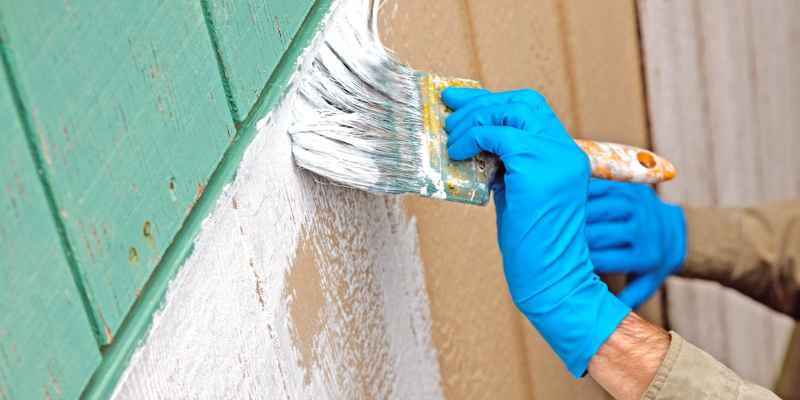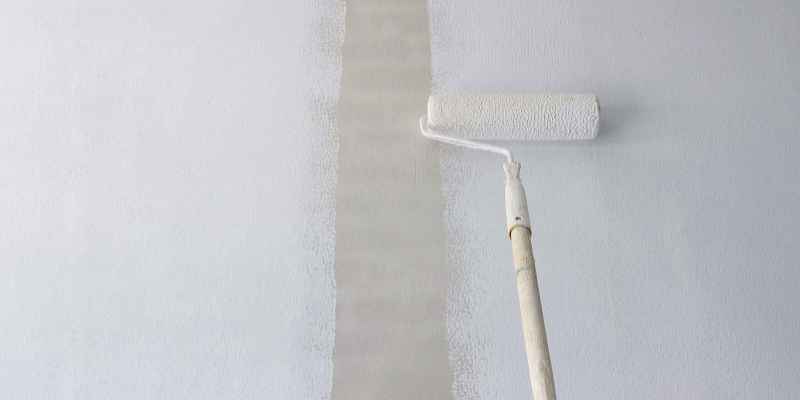Yes, you can use latex paint over oil-based primer. Latex paint can be applied over a properly prepared oil-based primer for a smooth and durable finish.
Using the right type of paint for your project is crucial to achieving a professional and long-lasting result. When it comes to painting surfaces that have previously been primed with oil-based primer, many people wonder if they can use latex paint as a topcoat.
Fortunately, the answer is yes. Latex paint is a popular choice for many homeowners and professionals due to its ease of use, quick drying time, and easy cleanup. However, before you apply latex paint over an oil-based primer, it’s important to ensure that the primer has been correctly prepared. We will explore the compatibility of latex paint with oil-based primer and discuss the necessary steps for a successful application.
Understanding Latex Paint And Oil Based Primer
When it comes to painting projects, it is essential to understand the properties of the paint and primer you are using. In particular, having a clear understanding of latex paint and oil-based primer can help ensure the success and longevity of your paint job. Below, we will explore the key characteristics of latex paint and oil-based primer, providing you with valuable insights to make informed decisions for your next painting endeavor.
Properties Of Latex Paint
Latex paint, also known as water-based paint, is widely used for interior and exterior applications, making it a popular choice among homeowners and professionals alike. This type of paint is made from an acrylic resin, which acts as the binder that holds the pigments together. Understanding the properties of latex paint can help you determine its suitability for your project.
- Easy Application: Latex paint is known for its ease of application, making it a preferred choice for DIY enthusiasts. It can be applied using a brush, roller, or sprayer and is quick to dry, enabling multiple coats to be applied in a day.
- Low VOC: Volatile Organic Compounds (VOCs) are harmful gases released by certain products, including some paints. Latex paint typically contains a low amount of VOCs compared to oil-based paint, making it a more environmentally friendly option.
- Flexibility: Because of its flexibility and ability to expand and contract with temperatures and humidity levels, latex paint is less prone to cracking or peeling. This makes it an excellent choice for surfaces that experience frequent temperature fluctuations.
- Clean-Up: Cleaning up after using latex paint is a breeze. Since it is water-based, simply using soap and water to clean your brushes and rollers is usually sufficient.
Characteristics Of Oil Based Primer
To achieve a smooth and long-lasting finish, many professionals rely on oil-based primers. An oil-based primer acts as a preparatory coat that helps improve adhesion, promotes uniformity, and enhances the durability of the paint job. Understanding the characteristics of oil-based primer can help you assess its suitability for your specific project.
- Superior Adhesion: Oil-based primers are known for their excellent adhesion properties, offering a strong bond between the surface and subsequent layers of paint. This makes them particularly useful for challenging surfaces, such as bare wood, metal, or surfaces previously coated with oil-based paint.
- Stain Blocking: Oil-based primers are effective at blocking stubborn stains, such as water stains, smoke marks, or ink. This feature makes them ideal for use in kitchens, bathrooms, or other areas prone to moisture or staining.
- Priming Power: Oil-based primers have outstanding priming capabilities, allowing them to seal porous surfaces effectively. This prevents the topcoat from soaking into the substrate, resulting in better coverage and a more even finish.
- Coverage: Oil-based primers typically provide better coverage compared to latex-based primers. They can mask imperfections, smoothen the surface, and help create a more professional-looking paint job.
By understanding the properties of latex paint and oil-based primer, you can make informed decisions to ensure the success and longevity of your paint project. Whether you choose latex paint for its ease of use or opt for oil-based primer to achieve superior adhesion, the right combination can result in a beautiful and long-lasting finish.

Challenges Of Using Latex Paint Over Oil Based Primer
Latex paint over oil based primer poses a challenge due to lack of adhesion, leading to peeling and cracking. To ensure successful application, sanding and priming with a bonding primer are recommended.
Using latex paint over oil-based primer can present several challenges. It is important to understand these challenges to ensure that your paint job lasts and looks its best. In this section, we will discuss the incompatibility issues, poor adhesion, peeling, and blistering that can occur when using latex paint over oil-based primer.
Incompatibility Issues
When you apply latex paint directly over oil-based primer, there can be incompatibility issues between the two products. Oil and water do not mix, and latex paint is typically water-based, while oil-based primer contains solvents. This difference in composition can lead to problems with the adhesion and performance of the paint.
Poor Adhesion
One of the main challenges of using latex paint over oil-based primer is poor adhesion. The latex paint may have difficulty adhering properly to the oil-based primer, resulting in a less durable finish. Without proper adhesion, the paint may not bond securely to the primer, leading to premature peeling, cracking, or flaking.
Peeling And Blistering
Another challenge that can arise is peeling and blistering. Due to the incompatibility between the latex paint and oil-based primer, the paint film can separate from the surface, causing it to peel or blister. This can be particularly frustrating as it not only affects the aesthetic appeal of the paint job but also requires additional time and effort for repairs.
Expert Tips For Using Latex Paint Over Oil Based Primer
When it comes to painting projects, knowing how to properly use latex paint over oil-based primer can make all the difference in achieving a smooth, long-lasting finish. Follow these expert tips to ensure successful results:
Proper Surface Preparation
Before applying latex paint over oil-based primer, it’s crucial to properly prepare the surface. Here are the key steps to follow:
- Clean the surface thoroughly to remove any dirt, dust, or grease using a mild detergent and water solution.
- Scrape off any loose or peeling paint using a putty knife.
- Sand the surface lightly with fine-grit sandpaper to create a smooth and even texture.
- Wipe away any sanding dust with a damp cloth and allow the surface to dry completely before moving on to the next step.
Using A Bonding Primer
In order to help the latex paint adhere properly to the oil-based primer, using a bonding primer is highly recommended. A bonding primer acts as a bridge between the two different types of paint, ensuring a strong bond and preventing any potential issues down the line. Follow these steps when applying the bonding primer:
- Choose a high-quality bonding primer specifically designed to be used with latex paint.
- Apply the bonding primer evenly to the surface using a paintbrush or roller, following the manufacturer’s instructions.
- Allow the bonding primer to dry completely before applying the latex paint.
Testing Compatibility
Prior to applying latex paint over oil-based primer, it’s important to test the compatibility between the two. Here’s how you can do it:
- Choose a small inconspicuous area on the surface to test.
- Apply a thin coat of latex paint over the oil-based primer and let it dry for at least 24 hours.
- Inspect the test area for any signs of peeling, bubbling, or poor adhesion.
- If the test proves successful, you can proceed with painting the entire surface.
Applying Thin Coats
When applying latex paint over oil-based primer, it’s best to apply multiple thin coats rather than one thick coat. This allows the paint to adhere better and ensures a smoother finish. Here’s how to do it:
- Dip the brush or roller into the latex paint and remove any excess paint.
- Apply the paint in even, overlapping strokes, working in small sections at a time.
- Allow each coat to dry completely before applying the next one.
- Repeat the process until you achieve the desired coverage and finish.
Allowing Sufficient Drying Time
Lastly, it’s crucial to allow sufficient drying time between coats and after the final coat. This ensures that the paint fully cures and provides maximum durability. Follow these guidelines:
- Consult the paint manufacturer’s recommendations for the recommended drying time between coats.
- Avoid rushing the process by exposing the painted surface to excessive moisture or heat.
- Allow the final coat to dry for at least 24 hours before subjecting the painted surface to any heavy use or cleaning.
Alternatives To Using Latex Paint Over Oil Based Primer
When painting over oil-based primer, you have alternatives to using latex paint. Explore other options to achieve the desired finish without compromising the integrity of your project.
If you’re tackling a painting project and wondering if you can use latex paint over oil-based primer, you’ll be glad to know that there are alternatives. While latex paint is a popular choice for its ease of use and quick drying time, it may not adhere properly to oil-based primer. Luckily, there are alternative routes you can take to achieve a smooth and lasting finish on your painted surface. In this article, we’ll explore three effective alternatives to using latex paint over oil-based primer.
Removing The Oil Based Primer
If you want to use latex paint on a surface that has been previously painted with oil-based primer, one option is to remove the existing primer. This can be a labor-intensive process, but it ensures a clean slate for your latex paint. Here are a few steps to consider:
- Prepare the area by covering nearby surfaces and furniture with drop cloths to protect them from debris.
- Use a paint scraper or sanding tool to gently remove the oil-based primer, taking care not to damage the surface underneath.
- After removing the primer, clean the surface thoroughly to remove any remaining debris or dust.
- Apply a fresh coat of water-based primer before painting with latex paint.
This method requires patience and precision, but it can give you the desired result of using latex paint on your project without compromising its durability.
Using A Stain Blocking Primer
If you’re working with a surface that has been stained or has a strong color, using a stain blocking primer can be an effective alternative to using latex paint over oil-based primer. Stain blocking primers are designed to seal the surface and prevent any discoloration or bleeding through from the previous layer. Here’s how to use a stain blocking primer:
- Prepare the surface by cleaning and sanding it to create a smooth base.
- Apply the stain blocking primer with a roller or brush, ensuring full coverage.
- Allow the primer to dry completely before applying latex paint.
Using a stain blocking primer can help you achieve a flawless finish, even if you’re working with a challenging surface.
Switching To A Water-based Primer
If removing the oil-based primer or using a stain blocking primer are not suitable options for your project, another alternative is to switch to a water-based primer. Water-based primers are compatible with both latex and oil-based paints, making them a versatile choice. Here are the steps to switch to a water-based primer:
- Clean and prepare the surface as usual, removing any loose paint or debris.
- Apply the water-based primer using a brush or roller, ensuring even coverage.
- Allow the primer to dry completely before applying latex paint.
Switching to a water-based primer provides a reliable solution for using latex paint, as it creates a strong bond between the paint and the surface.

Faqs About Using Latex Paint Over Oil Based Primer
Latex paint can safely be used over oil-based primer. It provides a durable and smooth finish for your project without the need for additional preparation.
Can You Use Oil Based Paint Over Latex Primer?
Yes, you can use oil-based paint over latex primer. However, there are a few important considerations to keep in mind. Firstly, it’s crucial to ensure that the latex primer has fully cured before applying the oil-based paint. This typically takes at least 24 hours, but it’s best to follow the manufacturer’s instructions for specific drying times.
Additionally, it’s important to scuff sand the dried latex primer before applying the oil-based paint. This helps to create a rough surface for better adhesion. Using a fine-grit sandpaper (such as 220 grit) or a sanding block, lightly sand the primer until it feels smooth. Be sure to wipe away any dust or debris with a clean cloth before applying the paint.
Is It Possible To Use Latex Primer Over Oil Based Paint?
No, it is not recommended to use latex primer over oil-based paint. The two types of paints have different properties and compositions, which can lead to poor adhesion and paint failure. Oil-based paint creates a hard, glossy finish that is difficult for latex primer to adhere to properly. To ensure the best results, it’s always best to use a primer that is compatible with the type of paint you plan to use.
What Happens If You Don’t Use The Right Type Of Paint Over The Primer?
If you don’t use the right type of paint over the primer, it can lead to adhesion issues, paint peeling, and a shorter lifespan for your paint job. Using latex paint over oil-based primer can cause the paint to not properly adhere, resulting in a lack of durability and potentially uneven coverage. Similarly, applying oil-based paint over latex primer can also lead to poor adhesion, causing the paint to peel or blister over time.
Can You Paint Over Oil-based Stain With Latex Paint?
Yes, you can paint over oil-based stain with latex paint. However, it’s essential to properly prepare the surface before applying the paint. Begin by cleaning the stained surface to remove any dirt, grease, or grime. Next, lightly sand the surface to remove any gloss or shine from the stain. This helps to create a rough surface for better paint adhesion. Finally, apply a latex primer suitable for covering oil-based stains before applying the latex paint.
Conclusion
To summarize, while oil-based primers have long been the go-to choice for their durability and adhesion, there is growing evidence that latex paint can be successful as a topcoat. However, it is crucial to ensure proper surface preparation and compatibility between the primer and the paint.
Always test in inconspicuous areas and consult with professionals if you’re uncertain. By taking these precautions, you can achieve a beautiful and long-lasting finish for your project. So go ahead and experiment, but remember to proceed with caution.


